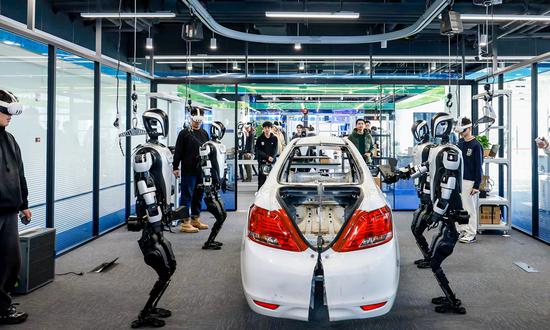Shanghai rolls out the China's first heterogeneous humanoid robot training ground

(Photo/Courtesy of Humanoid Robot Kylin Training Ground)
China's first heterogeneous humanoid robot training facility was officially inaugurated in Shanghai on Tuesday, a milestone in the country's efforts to advance the practical application and large-scale development of humanoid robots.
The training facility, also known as Humanoid Robot Kylin Training Ground, is owned by Shanghai-based National and Local Co-Built Humanoid Robotics Innovation Center, Humanoid Robot (Shanghai) Co.
Currently, the training ground is able to accommodate more than 100 humanoid robots, making it the largest of its kind in China. By 2027, it aims to train 1,000 general-purpose robots simultaneously, according to Yang Zhengye, the company's marketing director.
The humanoid robot training ground serves as an important infrastructure facility for promoting the development of the humanoid robot industry and the implementation of application scenarios. The training ground is vital for advancing the humanoid robot industry by facilitating collaboration among enterprises. It provides tailored training scenarios for sectors like intelligent manufacturing and public services, driving technology innovation and industrial upgrades.
To better train general-purpose humanoid robots, the training facility will cooperate with Shanghai-based robot manufacturers such as Zhiyuan Robotics and Kupas Technology Co, to collect a total of 10 million high-quality physical data entries by the end of 2025. This initiative aims to establish one of the foremost heterogeneous embodied datasets in the industry, said Yang.
This comes as China ramps up efforts to develop artificial intelligence and robotics, to gain an edge in the tech rivalry with the US as well as combat the challenges of an aging society, Jiang Lei, chief scientist of the innovation center, told the Global Times on Tuesday.
"Humanoid robots are stepping in to provide the necessary support, and help tackle the challenges posed by an aging population. The integration of advanced embodied intelligence and autonomous driving technologies has unlocked new capabilities, allowing humanoid robots to become smarter and more flexible," Jiang noted.
Next, the center is set to unveil the 2.0 version of its humanoid robot, dubbed "Deep Snake," highlighting the significance of core technologies such as linear joint actuator for enhancing the performance and functionality of robots, according to Jiang.
The development of the humanoid robot industry, driven by both technology and policy, has entered the fast lane of development. Data from a recent industry report showed that the market for humanoid robots in China in 2024 was approximately 2.76 billion yuan ($379 million). The report predicted that the Chinese humanoid robot market will reach 16.7 billion yuan in 2025, and is anticipated to soar to 86.1 billion yuan by 2030.
Local governments across China are rushing to introduce policies to level up the innovation and deployment of humanoid robots. Policy support includes financial, venue, talent and other aspects, encouraging the investment enthusiasm of social capital, said Jiang.
Beijing, for instance, plans to prioritize the development of future industries including humanoid robots, commercial space, biomanufacturing and new materials in 2025, according to the government work report presented to the third session of the 16th Beijing Municipal People's Congress on January 14. Meanwhile, the Global Times learned from local authorities that the city is preparing for hosting the inaugural World Humanoid Robot Sports Games later this year.
"Tiangong," the world's first full-size, purely electric-humanoid robot, is scheduled to run a marathon race in April in Beijing. Measuring 1.63 meters in height, the robot can maintain a steady running speed of 6 kilometers per hour, according to its developer, China's Embodied Artificial Intelligence Robotics Innovation.
Authorities in East China's Zhejiang Province are dedicated to promoting the application of humanoid robots infused with more intelligence, efficiency and modularization in the next step of their development in the industry. They aim to achieve an annual production capacity of 20,000 robots by 2027, with the core industry scale reaching 20 billion yuan, and the related industry scale is expected to reach 50 billion yuan.
